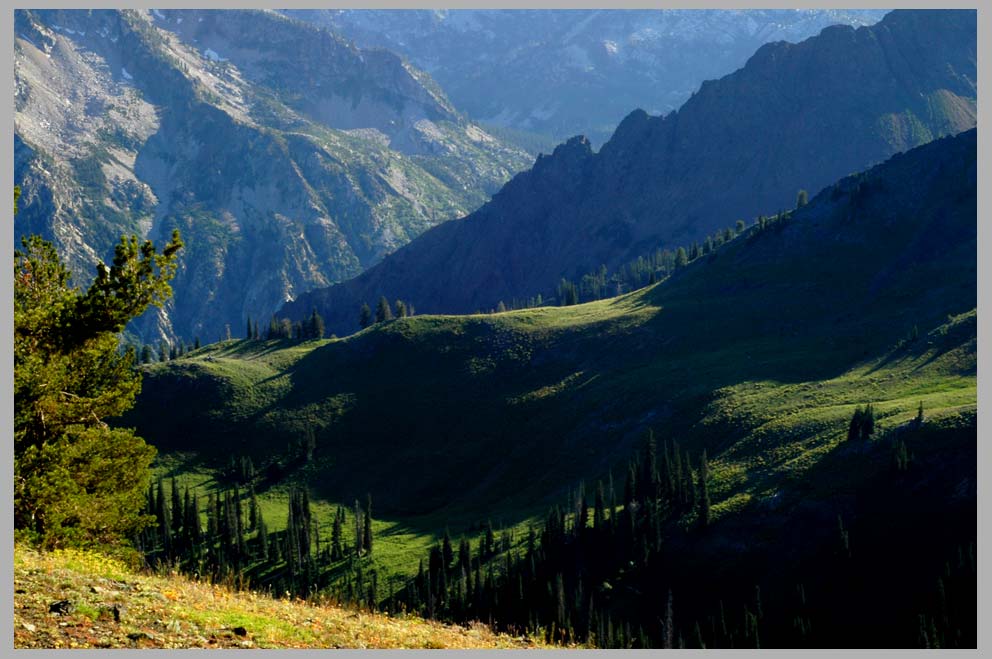

Above Norway Basin, view southwest with early evening light [ click photo for next . . . ]


Above Norway Basin, view southwest with early evening light [ click photo for next . . . ]
TOPO of area above Norway
Basin, pictured above. What I call MC
Ridge, a natural divide between the High
Wallowas to the west, and Canyon Country
to the east, at 2400 m., (top left on topo)
is where the photo was made. It also marks
the side of the Wallowas that is evidently
getting hardest hit by climate change. Northeast
of the divide, in my view, things are getting hotter
and drier. And more prone to burn.View for yourself why I call this MC
Ridge, a natural divide between the High
Wallowas to the west, and Canyon Country
too the east, at 2400 m. These two photos
were made at the same time, exactlly
the same place. All I did was turn my
tripod 180 degrees to face east northeast.
Much of this area has recently burned.
On the road in the Northwest of America.
NEVER HEARD BEFORE
I awoke to new
stars, to the sound
of a bird:—
never heard before.
ON THE NECESSITY OF CULTURE
NESTED WITHIN WILD NATURE
Just as the world needs vast stretches of healthy interconnected road-
less wilderness, so too, in my view, the world needs special areas in
which people are encouraged to build small shelters, homesteads and
self-sustaining villages within that same wilderness. And what is more,
I think the two must of necessity be nested one within the other as a
kind of mutually self-sustaining complementarity. This I would say as
long as we keep to the strict limiting factor of:—no roads.
Why? I would say, because this would offer opportunities to demon-
strate new solutions to the perennial problem of Culture co-existing in
harmony with Nature. After all, that is one of the primary problems not
only of our time, but I would argue, of any time.
At present, as seen by the contemporary North American metaphysics
of wilderness, the primary challenge is the on-going two-step task of
fighting to acquire wilderness, and then protecting it. A key underlying
assumption here is that the best way to protect something is to isolate
it. And indeed, when it comes to roads, trucks, cars, snowmachines,
chainsaws and the myriad other structures and artifacts of hydrocarbon
culture generally, this may indeed be the case. But we should also be
aware that it is but one small step from the isolation which walls-out
like a medieval mote what we don’t want in, to the fragmentation
which becomes more like a prison locking-in and locking-out spe-
cies—including ourselves—on either sides of the barrier.
In a way, I would suggest that the challenge of culture-plus-wilderness,
or how to live sustainably and artfully not just in a material, but also in
a spiritual sense, upon the Land is a much greater one. And it is a chal-
lenge which has the energy and urgency of necessity behind it. Why?
Because we contemporary humans are children of an amazingly imbal-
anced culture. On the one hand, we have our remarkable and revolution-
ary technologies of information. On the other, we have our dangerously
outmoded, non-sustainable and destructive energy technologies together
with the runaway militarism absolutely necessary to support these. My
contention is, that we too, just as other generations who have come
before us, also need a clear slate upon which to demonstrate new ideas,
new skills and crafts in designing renewable structures of all kinds,
structures which nest themselves harmoniously within Nature’s web.
Contemporary humans, like all members of our unique yet troubled
species who have gone before us, need the chance to build a home and
a path, which, like the best of those of the past, might last a thousand
years or more.
The question I ask myself is whether humankind may once again be-
come not man the destroyer, but man the creator. The creator of new
habitat. We already have much of the necessary knowledge. And we
certainly have much of the necessary technology. Now we need the find
the wisdom to limit the power of those tools, and the energy to gain the
insights which will reveal the appropriate places, scales and seasons.
For me, the notion of protection of wilderness is as necessary as it is in
my view at present unfortunately somewhat one-sided. I think we need
the idea of humankind not just as “a temporary visitor” in wildness, but
rather also humankind—in the right place and at the right scale—as a
permanent co-inhabitant and resident protector of special areas of the
wild land.
THE LITTLE CLAVIER please preview 150 of 631 pages
w/ my black & white photography [opens in new window]
s
All Photographs & texts by Cliff Crego © 1999 -2011 picture-poems.com
(created: V.27.2011)